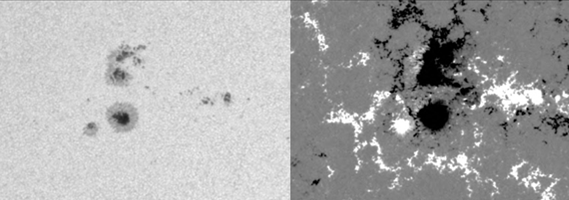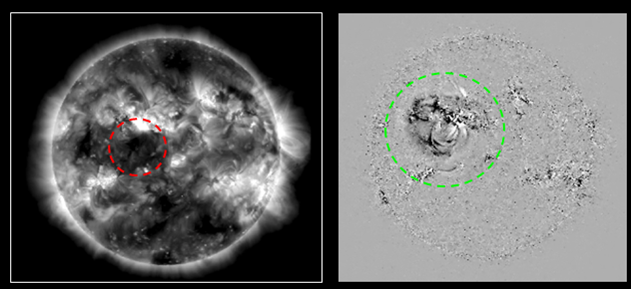No doubt about it: The M6 flare in sunspot group NOAA 1719 was the highlight of last week's space weather activity.
A movie was created showing the various aspects of this flare and its impact on Earth. Some additional details can be found underneath.
NOAA 1719 was a relatively simple group, but possessed some spots of opposite magnetic polarity close to each other. The flare took place along the line separating these fields of opposite magnetic polarity. The M6.5 flare peaked at 7:16UT (11 April), and lasted for 34 minutes. It is noteworthy that NOAA 1719 was also the source of an M2 flare about a week earlier, while it was still near the east limb.

The next part of the movie shows the flare in successively higher and hotter levels of the Sun's atmosphere: From the relatively cool chromospheric layer via the transition zone into the million degrees hot corona. The outlook changes dramatically, with post-flare coronal loops becoming better visible as temperatures increase. In the cool chromosphere, the flare was very bright and also big, being about 6 times as large as the Earth's surface area.
The SDO/AIA 193 and the PROBA2/SWAP 174 images show quite well the EUV dimmings and the EIT wave associated with the flare. EUV dimmings are also called transient coronal holes, as they indicate places where material temporarily punched a hole through the corona while being ejected from the Sun. The EIT wave is best visible in difference-images (one image being subtracted from the previous), propagating at a speed of several hundred kilometers per second in the plane-of-sky.

The SDO/AIA combo movies provide a good zoom on the blast area showing the post-flare coronal loops and the interaction with the surroundings particularly well. The continuous series of coronal loops is called an arcade.

Already 1.5 hours later, energetic protons from this event arrived at Earth. Both the x-ray radiation as the proton event degraded the HF communication on Earth moderately, resp. over Asia (x-ray) and over the polar regions (protons).
The Humain solar radio telescope very nicely captured the radio bursts associated with this event, as material traveled through the corona. The Type 2-burst in particular was distinct, and indicated the ejection of plasma.
Images made by the coronagraphs of the SOHO, STEREO-A and -B spacecraft confirmed there was a coronal mass ejection. The CME was a full halo in both the SOHO and STEREO-A spacecraft. This meant the plasma cloud was heading for Earth. It had also a very strong asymmetry of the material distribution towards the east. It is also interesting to note that the speed of the disturbance gradually decelerated from around 1160 km/s to 800 km/s as the CME progressed through the C2 and C3 fields of view of the SOHO/Lasco coronagraph.

The CME arrived late on 13 April. Having a predominantly north oriented and relatively weak magnetic field, it resulted in only unsettled geomagnetic conditions. Polar lights were well visible only from Alaska and Scandinavia.
Credits – Images and data were taken from SDO, SOHO, PROBA2, STEREO, GONG/H-alpha Network, Humain Solar Radio telescope, ACE, NOAA/SWPC and SIDC, and processed with JHelioviewer.
 |
 |





